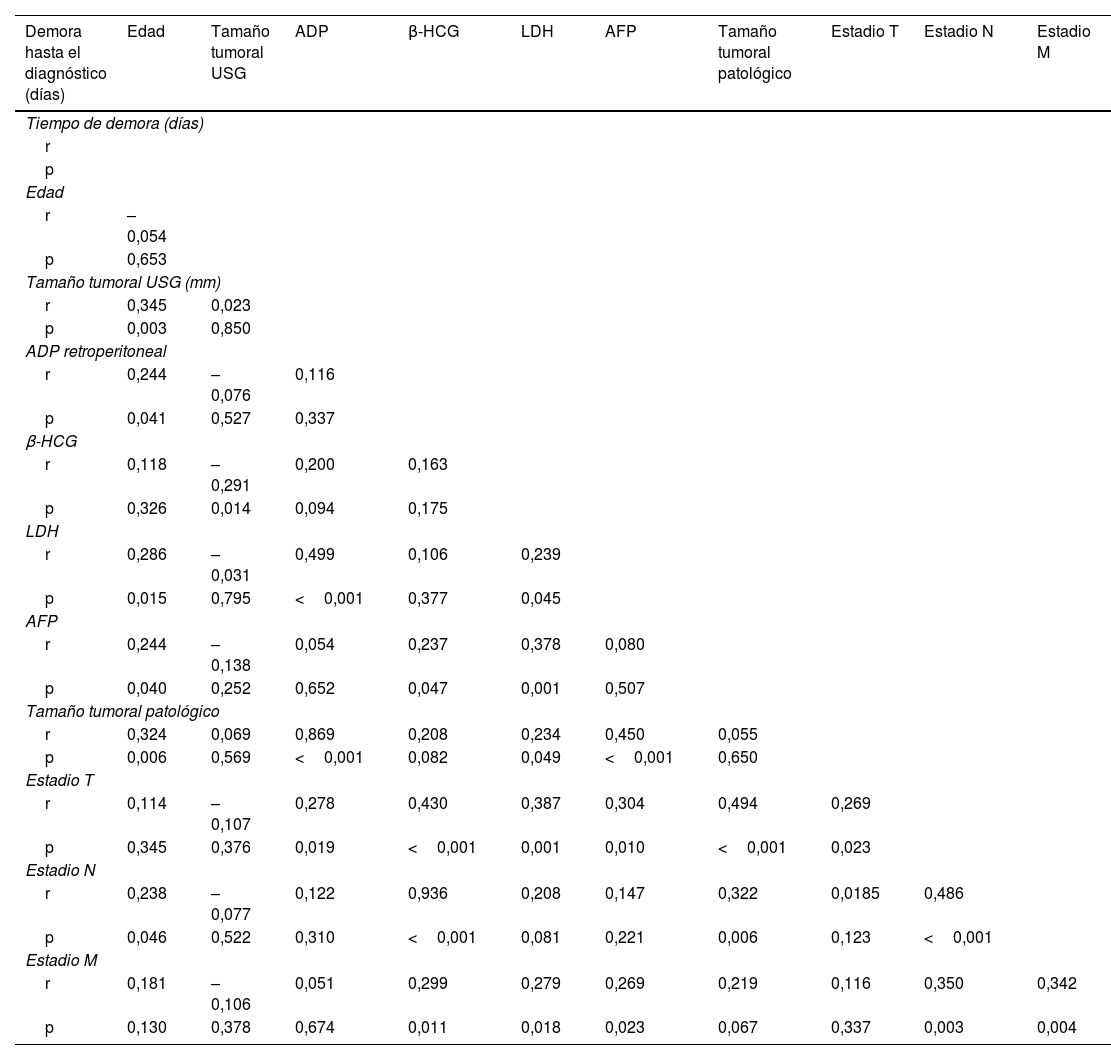El impacto positivo del diagnóstico precoz sobre la supervivencia del cáncer testicular es bien conocido desde hace muchos años. El objetivo de este estudio fue determinar las características diagnósticas de los pacientes con cáncer testicular, examinar el impacto del retraso en el diagnóstico (RD) sobre el tamaño del tumor, el estadio tumoral y los marcadores tumorales séricos, e identificar los posibles beneficios del diagnóstico precoz.
MétodosSe incluyó en el estudio a 71 pacientes tratados mediante orquiectomía inguinal por sospecha de cáncer testicular, cuya enfermedad se confirmó como tumor de células germinales. Se examinó la relación entre el tiempo de retraso en el diagnóstico y el tamaño del tumor, los niveles de los marcadores tumorales, el estadio TNM, la presencia de adenopatía (ADP) y de metástasis.
ResultadosSe detectó seminoma en 39 (54,9%) pacientes y tumor no seminomatoso en 32 (45,1%) pacientes. En el análisis de correlación entre marcadores, se encontró una correlación significativa y positiva entre el RD y el tamaño tumoral determinado por pruebas radiológicas (tamaño radiológico), el tamaño tumoral determinado por el estudio patológico (tamaño radiológico), la tasa de detección de ADP retroperitoneal, los niveles de LDH y AFP, y estadio N (respectivamente, r=0,345 p=0,003, r=0,324 p=0,006, r=0,244 p=0,041, r=0,286 p=0,015, r=0,244 p=0,040, r=0,238 p=0,046). Se determinó que un aumento de 1 día en el RD provocaba un aumento de 0,431mm en el tamaño patológico del tumor.
ConclusiónEl tiempo de retraso en el diagnóstico es un aspecto relevante en el contexto de los tumores testiculares. El retraso en el diagnóstico no solo produce un aumento del tamaño tumoral, sino que también afecta negativamente el estadio tumoral y los factores pronósticos.
In testicular cancer, the positive effect of early diagnosis on survival has been known for many years. In this study, we aimed to determine the diagnostic features of testicular cancer patients, to examine the effect of duration of diagnosis delay (DD) on tumor size, tumor stage, and serum tumor markers, and to reveal the possible benefits of early diagnosis.
MethodsA total of 71 patients who underwent inguinal orchiectomy due to suspicion of testicular cancer and whose pathology was found to be the germ cell tumor were included in the study. The relationship between the duration of diagnosis delay and tumor size, level of tumor markers, TNM stage, presence of LAP, and presence of metástasis were examined.
ResultsSeminoma was detected in 39 (54.9%) patients and non-seminoma tumor was detected in 32 (45.1%) patients. In the correlation analysis between the markers, a significant and positive correlation was found between DD and radiological tumor size, pathological tumor size, retroperitoneal LAP detection rate, LDH and AFP levels, and N stage (respectively; r=0.345 p=0.003, r=0.324 p=0.006, r=0.244 p=0.041, r=0.286 p=0.015, r=0.244 p=0.040, r=0.238 p=0.046). It was determined that a 1-day increase in DD caused an increase of 0.431mm in the pathological size of the tumor.
ConclusionDuration of diagnosis delay is an issue that still keeps its importance for testicular tumors. Delay in diagnosis not only leads to an increase in tumor size but also negatively affects tumor stage and prognostic factors.
Artículo
Comprando el artículo el PDF del mismo podrá ser descargado
Precio 19,34 €
Comprar ahora













